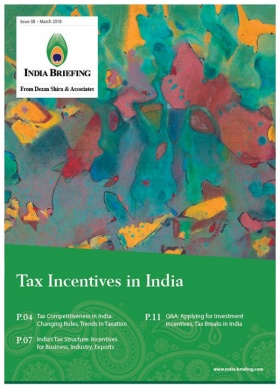British Business Preparing for Brexit by Massively Increasing Investments in India
British businesses have been anticipating Brexit by increasing their investments into India by a significant amount in 2018. This continues a trend seen elsewhere in China and Russia as UK companies look to diversify their overseas investments into non-EU markets.
The India data, gathered from the Indian Department of Industrial Policy & Promotion (DIPP) show that British investment into India has increased from an average of US$70 million per month in the period April 2017 to March 2018, to US$216 million per month in the last reported quarter, April-June 2018. That represents an overall increase of 31.4 percent.
Although the DIPP data is somewhat basic and isn’t yet broken down into categories, this nevertheless shows a developing trend, just as it has elsewhere in Asia as concerns UK investment heading east.
These figures are also supported by Dezan Shira & Associates own Asian analysis for 2018 year to date. The firm handles foreign direct investment into Asia and possesses offices in India as well as several ASEAN nations, China, and Russia.
Commenting that the firm is seeing an Asian manufacturing boom, the practice itself reports a 10 percent increase in revenues into India, with China revenues increasing by an average of nine percent. Vietnam, however, showed an increase of 35 percent while other ASEAN nations of Indonesia, Philippines and Thailand all scored high revenue increases.
Although these were not solely UK investment driven, the figures at least support the fact that FDI globally is shifting in Asia. Part of that is driven by the US trade spat with China, which may possibly be affecting FDI moves into India as the China tariffs begin to bite.
This makes India an attractive alternative manufacturing destination as it can additionally offer a cheaper manufacturing cost base and has a significant domestic market in its own right. With Indian manufacturing goods generally not subject to the same level of tariffs that the US is now imposing on China, India’s move to be the world’s factory is getting a boost.
In 2017-18, India attracted US$44.8 billion in FDI inflows – the highest ever for any financial year. Most of the country’s FDI came from Mauritius, Singapore, Netherlands, Japan, and the US.
The sectors that received maximum foreign inflows are: services (US$6.7 billion), computer software and hardware (US$6.15 billion), telecommunications (US$6.21 billiob), trading (US$4.34 billion), infrastructure (US$2.73 billion), automobile (US$ 2 billion), and power (US$1.61 billion).
To maximize profits, most investors establish a physical presence in the country through either a liaison office, branch office, or through partnerships.
With regards to taxation, foreign companies conducting income generating activities in India are liable to a 40 percent CIT rate and surcharge, education cess, secondary and higher education cess. The surcharge is two percent or five percent if the income is over US$154,882 (Rs 10 million) or US$1.55 million (Rs 100 million), respectively. The education cess is two percent and the secondary and higher education cess is one percent.
British businesses, with both an eye on Brexit and the changing global supply chain moving partly away from China, now appear to be investing in India as a safe and potentially lucrative alternative destination.
About Us
India Briefing is produced by Dezan Shira & Associates. The firm assists foreign investors throughout Asia and maintains offices in China, Hong Kong, Indonesia, Singapore, Vietnam, and Russia.
Please contact india@dezshira.com or visit our website at www.dezshira.com.
- Previous Article Opportunités pour l’Investissement Français en Inde
- Next Article Manufacturing and Trading in India – New Issue of India Briefing Magazine Out Now








